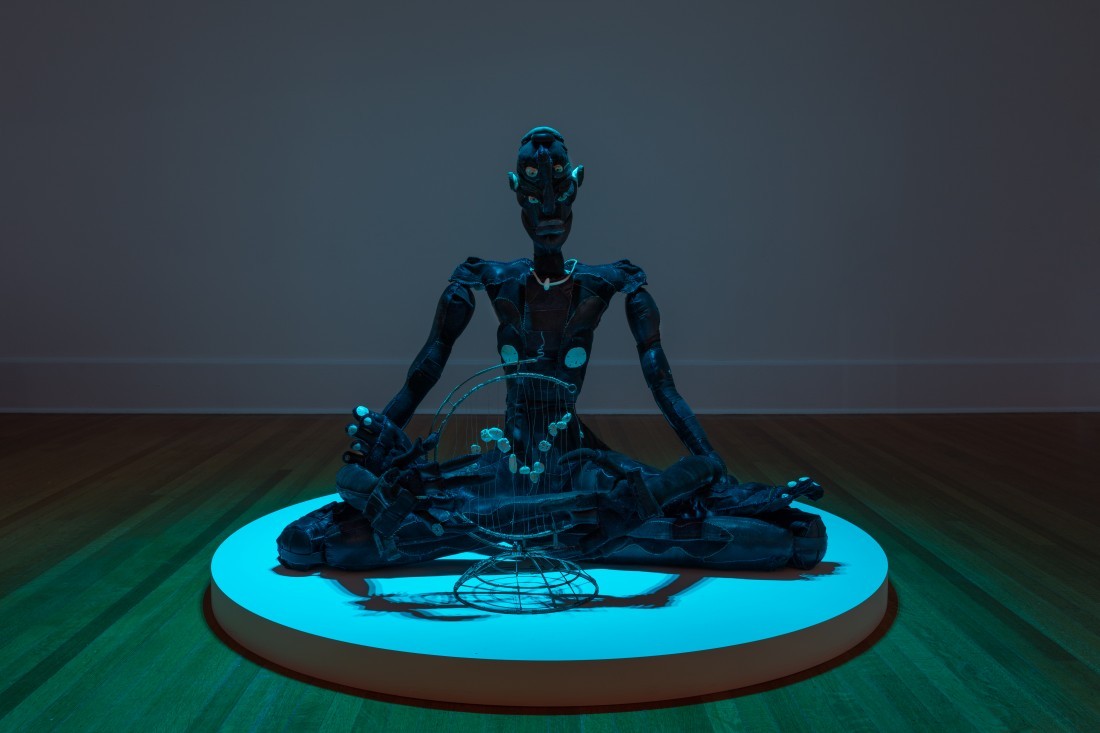Tau Lewis
Toronto-based but currently peripatetic artist Tau Lewis has recently been attracting international attention, notably at large American institutions such as MoMA PS1, the Hammer Museum, LA, and the New Museum in New York. Meanwhile, in the inverse relationship typical of Canadian artists garnering success elsewhere, larger Canadian institutions have so far overlooked her work. In contrast, public regional galleries—the Agnes Etherington Art Centre, the Kenderdine Galleries and now the Oakville Galleries—have granted her deserved acknowledgement.
A journalism school dropout and self-taught artist, Lewis is an anomaly in the current MFA and PhD culture with its emphasis on scholarly theory over skill. As opposed to deskilling, her sculpture involves the laborious processes of craft, ranging from doll making to quilt making; in other words, she works in media traditionally slotted as “women’s art.” Furthermore, by circumventing academic figurative sculpture, favouring naïve or outsider sculpture often associated with African-American art, her work classifies as “Black art.” She finds herself in a doubly marginalized position.
At the same time Lewis shows a razor-sharp awareness of contemporary art, highlighted in a wall piece forming part of an installation within the exhibition, titled Sparkle & Sparkle’s map home, 2018. Here, her play with material more closely resembles Rauschenberg’s intricate and noisy but pitch-perfect assemblages than it does folk art. The patchwork surface, doubly recalling a quilt and Rauschenberg’s rectangular configurations, is rough-hewn and confidently bold. Verticals with black, dark brown and grey fabric pull sharply downwards, an evincement of the power and spontaneity of gestural drawing and painting. Within this dynamic composition, Lewis has woven small surprises for archaeological extraction by curious viewers: a small cross, hardware odds and ends such as rusted washers, an antique photograph of a Black woman and her own clothes and jewellery. Other works also include autobiographical elements. For example, seashells from a collection the artist has amassed since childhood substitute as counters for an abacus-like construction repurposed from the skeletal framework that once held a globe (Harmony, 2019). These personal additions build on what is already warm, intimate work. Consider the androgynous black figure reclining in an old, rickety chair facing the wall piece (both are part of the same installation), who lends comforting hominess to the white cube. The paint splatters on the chair suggest it might be an unstated self-portrait of the artist scrutinizing her work. However, her work holds more sinister implications. Do the small locks and short chains that help to build the seated figure or the lock and handcuff embedded in the wall assemblage signify slavery? Elsewhere, Lewis subtly links the personal to slave history. Her collected seashells draw attention to her Jamaican heritage and by extension the African diaspora. The diaspora’s cultural trauma could lie behind the therapeutically recuperative nature of the repetitive Zen-like work of Lewis’s intensive assemblage and sewing. Alongside Black history, Lewis symbolically presents a Black future.

Tau Lewis, Harmony, installation view, 2019, recycled leather, recycled poly fibres, rebar, wire, hardware, seashells, stones, acrylic paint. Photos: Laura Findlay. Courtesy Oakville Galleries.
Her exhibition statement summarizes her project as “reenvisioning Gairloch Gardens as a scene from the cosmos,” in which “Lewis reflects on the possibilities of outer space as a locus of both a black past and a black future.” Here, the exhibition text alludes to the art world’s oft-adopted Afrofuturism—the representation of African diaspora culture by inserting inclusive narratives in the largely white science fiction genre. Still, Lewis’s approach is more abstract than seminar-room theoretical. She only infers sci-fi or futurism. For instance, in Harmony the slender, double-headed figure sitting in a yogi lotus pose atop an unnaturally glowing blue, circular pedestal resembles a visitor from a mythological alternate universe. Whether star-bound alien or ancient sea deity with seashells for toenails, the figure’s black leather patchwork delineates it as a Black body. Black history and future merge to convey open-ended meanings.
However, at the few fleeting points when Lewis’s art reads literally, it falters. One of these is her directly associating the global with the individual in The Octonaut (I can be my own hands to hold), 2019. Here, a wire-wrought globe, partially covered with tooled scrap metal continents, serves as a helmet for a grotesque visage whose bulging eyes poke out of their sockets. This connection is too blatant, as are the references of two untitled wall murals to futurism, with their planetary orbs and starry night backdrop. Maybe these straightforward gestures are flickers of self-consciousness resulting in explication beyond the openendedness that, in contrast, drives her work by stimulating viewers’ curiosity. It’s my sense that such open-endedness will allow Lewis to maintain longevity beyond her present good fortune in having a practice that crosses multiple art world trends—figuration, feminism, identity politics—and Rauschenbergian influence.
“Tau Lewis: Sparkle’s Map Home” was exhibited at Oakville Galleries in Gairloch Galleries, Oakville, ON, from January 26 to March 22, 2020.
Earl Miller is an independent art writer and curator based in Toronto.

